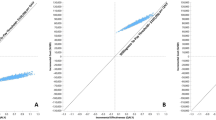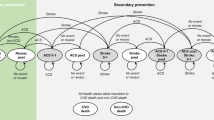Abstract
Background
Following suggestions that developers should be allowed to capture a defined share of the total value generated by their technologies, the amount of surplus accruing to the pharmaceutical industry has become an important concept when discussing policies to encourage innovation in healthcare.
Methods
Observational clinical and market data spanning over a period of 20 years were applied in order to estimate the social surplus generated by pharmaceuticals used in the management of high cholesterol and chronic obstructive pulmonary disease (COPD). The distribution of social surplus between consumers and producers was also computed and the dynamics of rent extraction examined.
Results
Health-related social surplus increased consistently over time for both disease areas, mostly due to the launch of more effective technologies and a greater number of patients being treated for the conditions. However, the growth rate of social surplus differed for each disease and dissimilar patterns of distribution between consumer and producer surplus emerged across the years. For lipid-lowering therapies, yearly consumer surplus reaches 85 % of total health-related social surplus after the loss of exclusivity of major molecules, whilst for COPD it ranges from 54 to 69 %. Average producer surplus is approximately 25 % of total health-related social surplus in the lipid-lowering market between 1990 and 2010, and 37 % for COPD between 2001 and 2010. The share of surplus captured by non-innovative generic producers also varies differently across periods for both markets, reaching 11.12 % in the case of lipid-lowering therapies but just 1.55 % in the case of COPD.
Conclusion
A considerable amount of the value may be recouped by consumers only towards the end of the lifecycle. Elements affecting the distribution of social surplus vary across disease areas and include the market pricing structure and the pattern of clinical effectiveness observed over time. The application of a longer-term disease specific perspective may be required when assessing the cost-effectiveness of health technologies at launch.


Similar content being viewed by others

References
Grabner, M., et al.: The value of atorvastatin over the product life cycle in the United States. Clin. Ther. 33(10), 1433–1443 (2011)
Garthwaite, C.: The economic benefits of pharmaceutical innovations: the case of cox-2 inhibitors. Am. Econ. J. Appl. Econ. 4(3), 116–137 (2012)
Cutler, D., et al.: The value of antihypertensive drugs: a perspective on medical innovation. Health Aff. 26(1), 97–110 (2007)
Goldman, D., et al.: The value of specialty oncology drugs. Health Serv. Res. 45(1), 115–132 (2010)
Jena, A., Philipson, T.: Cost-effectiveness as a price control. Health Aff. 26(3), 696–703 (2007)
Philipson, T., Jena, A.: Who benefits from new medical technologies? Estimates of consumer and producer surpluses for HIV/AIDS drugs. Forum Health Econ Policy 9(2) (2006), doi: 10.2202/1558-9544.1005
Lakdawalla, D., et al.: An economic evaluation of the war on cancer. J. Health Econ. 29(3), 333–346 (2010)
Lindgren, P., Jönsson, B.: Cost-effectiveness of statins revisited: lessons learned about the value of innovation. Eur. J. Health Econ. 13(4), 445–450 (2012)
Culyer, A., et al.: Searching for a threshold, not setting one: the role of the National Institute of Health and Clinical Excellence. J. Health Serv. Res. Policy 12(1), 56–58 (2007)
Refoios Camejo, R., et al.: The determinants of cost effectiveness potential: a historical perspective on lipid lowering therapies. Pharmacoeconomics (2013) doi: 10.1007/s40273-013-0041-x
RefoiosCamejo, R., et al.: Assessing the determinants of the potential for cost effectiveness over time: the empirical case of COPD. Value Health 16(2), 426–433 (2013)
ONS: All items retail price index (RPI) percentage change over 12 months: Table RP04. (2010) Office for National Statistics
Healthcare Commission: Clearing the air: a national study of chronic obstructive pulmonary disease. Healthcare Commission, London (2006)
National Institute for Health and Clinical Excellence: Guide to the methods of technology appraisal. National Institute for Health and Clinical Excellence, London (2008)
Pinheiro, E., et al.: Examining the production costs of antiretroviral drugs. AIDS 20(13), 1745–1752 (2006)
Reiffen, D., Ward, M.: Generic drug industry dynamics. Rev. Econ. Stat. 87(1), 37–49 (2005)
Caves, R., Whinston, M. and Hurwitz, M.: Patent expiration, entry and competition in the US pharmaceutical industry. In: Brookings Papers on Economic Activity. pp. 1–66 (1991)
Department of Health. Quality and outcomes framework. 18th September 2012; Available from: www.dh.gov.uk/en/Policyandguidance/Organisationpolicy/Primarycare/Primarycarecontracting/QOF/index.htm
Jena, A. and Philipson T.: NBER working paper no. 15032: endogenous cost-effectiveness analysis in health care technology adoption. (2010), http://www.nber.org/papers/w15032
Abbott, T. and Vernon J.: The cost of pharmaceutical price reductions: a financial simulation model of R&D decisions, in NBER Working Series. (2005): Cambridge
Danzon, P., Wang, Y., Wang, L.: The impact of price regulation on the launch delay of new drugs. Health Econ. 14(3), 269–292 (2005)
Friederiszick, F., et al.: An economic assessment of the relationship between price regulation and incentives to innovate in the pharmaceutical industry. European School of Management and Technology, Berlin (2009)
Jena, A., Philipson, T.: Cost effectiveness analysis and innovation. J Health Econ. 27(5), 1224–1236 (2008)
Refoios Camejo, R., McGrath, C., Herings, R.: A dynamic perspective on pharmaceutical competition, drug development and cost effectiveness. Health Policy 100(1), 18–24 (2011)
Acknowledgments
Whilst conducting this study, R.R.C. was supported by the Portuguese Fundação para a Ciência e a Tecnologia (FCT), and C.McG. was an employee of AstraZeneca. However, ideas expressed in this paper are entirely those of the authors and do not necessarily represent the views of FCT or AstraZeneca. We thank Mendel Grobler, Simon Walker and Elangovan Gajraj for their insightful comments on a previous version of this manuscript. The usual disclaimer applies.
Author information
Authors and Affiliations
Corresponding author
Rights and permissions
About this article
Cite this article
Camejo, R.R., McGrath, C., Miraldo, M. et al. Distribution of health-related social surplus in pharmaceuticals: an estimation of consumer and producer surplus in the management of high blood lipids and COPD. Eur J Health Econ 15, 439–445 (2014). https://doi.org/10.1007/s10198-013-0484-1
Received:
Accepted:
Published:
Issue Date:
DOI: https://doi.org/10.1007/s10198-013-0484-1
Keywords
- Consumer surplus
- Producer surplus
- Dynamic efficiency
- Research and development
- Pharmaceutical innovation
- Pharmaceutical policy



